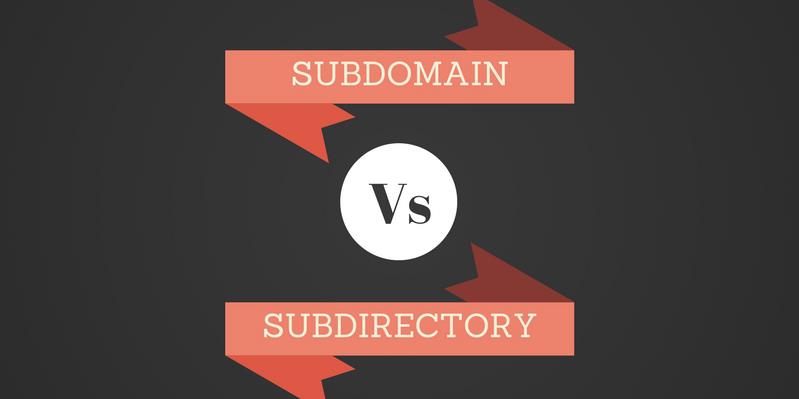Subdomain vs. Subdirectory: What is better for SEO in 2017?
People want to ensure that their business ranks higher in the Google search results and they are going to greater lengths to sort these things well.
In today’s time, there has been a sudden increase in the inclination towards the scope for digital marketing. For people who are aware of the technicalities of the SEO, the biggest debate remains the employment of the subdomain and the subdirectory. To understand the two, one must know the importance of SEO. Since SEO is targeted content, the two elements have a lot to do with your website’s line of business.
Everything that you write on the internet must be written with a motive. In the world of blogging, there is no place for useless content. To be able to succeed, one must put in detailed and concise information which is meant for the targeted audience, which would include the setting up a website along with keywords, main content, titles as well as metadata descriptions. The graphics, colors and the design of the site should also be in place. All these affect the ranking of the page on the Google search results.
But for SEO, what is it that should be used? There has always been a controversy between Subdomains vs. subdirectories. Let us look at the difference.
Difference between Subdomain and Subdirectory
A subdomain is the first part of the domain which comes before the period or in simpler terms a field which is a part of the main domain. So, when you use a subdomain, the URL would look something like this – subdomain.domain.com.
The subdomain part present before the main domain tells Google as well as the visitors that the content present in the subdomain is different from the content which is present in the rest of your website. A classic use of the sub-domains is basically for a business site wherein the blog is distinct from the others and therefore resides on the subdomain of its own.
Example – life. domain.com, jorney.example.com.
When comparing subdomain to a subdirectory, we need to understand that a subdirectory is the folder which is attached to the domain. A subdirectory looks something like this – domain.com/subdirectory.
However, the difference isn’t entirely in the syntax. It is more than that and is related to the kind of content that your website has. However, if you feel that the content on your site is good enough for a full-fledged site, then subdomains would be the best option to choose. In case the content isn’t much different from that of the main content, sub directories can be put on the table.
To have a better understanding of subdomain and subdirectory, let us have a look at this example. If your blog is related to DIY’s, you may have a separate subdirectory for all the tutorials, artwork or free stuff. However, in the section wherein you sell your DIYs, content must be put into a separate domain.
Example – DIY.domian/tutorial, DIY.domain/free templates.
When can Subdomain be used?
There are several reasons as to why you should use a subdomain. You might want to use a subdomain if:
- There are multiple languages that are being used on the site.
- You have several pages for one keyword.
- You sell several different products which are not actually related to each other or have a variety of storefronts.
It is in such cases that a subdomain can be used to differentiate one thing from the other. Also, one must remember that Google, in general, limits the number of search results of each domain unless and until they are relevant. When comparing subdomain to subdirectory, one must understand that this isn’t applicable to subdomains.
In simpler terms, if you have a domain that has subdirectories and you get about 10 relevant results, Google would most likely show only about 2 to 3 of them. But, if you have 5 subdomains, there are high chances that you would be able to get 2 to 3 results for each of the subdomains. This means that a total of ten to fifteen would be shown together. However, this cannot be taken just for granted and used just for the sake of tricking Google as this might not work for your site and would only lead to wastage of time and effort.
Also, with subdomains, you can put the keywords as the names of the sub domains. This would help in getting better ranking.
When can Subdirectory be used?
Using a subdirectory can benefit you in several ways.
- You would get to use the keywords in the URL similar to that of a subdomain.
- One of the biggest advantages of the subdirectory is the fact that they inherit the root domain’s metrics. This means that if your website is performing well as a whole, any of the content present in the sub directory or the sub-folder would be able to benefit from this.
However, with the subdomain, you would have to put in a lot of effort behind SEO right from the beginning.
A subdirectory would also be useful if your business operates in a single location and uses only one language. It is rather useful if you want to make sure that all your pages are easy to find and navigate without having to point at different sites. This would also prove to be beneficial if the branding on your site is similar to all the services and you do not require separating any services.
Wrapping up:
In the debate over the use of subdomain and subdirectory, some prefer subdomains whereas others would say a sub directory is the best option. For instance, if you have a health website, you can use subdomains for topics that are larger like separate domains for each of the major diseases and then create a subdirectory for the different diseases that fall into the group of those major diseases.
Many would claim that subdirectories are much better for SEO as they help in getting more hits. In the fight between subdomains vs. subdirectory, it is entirely up to your needs and purpose as to what you choose. This is because both work on to effectively improve the SEO. The two variables might be a little dicey to understand, but if put to proper use, they will bring their kind of benefits to your valuable website.
Related Posts
To succeed, digital marketing teams must increasingly concentrate on and learn about optimizing marketing processes.
In almost all forms of modern business, marketing is an essential function.
To make your business successful in the modern age, you need to excel at digital marketing and have a strategy that can allow you to beat out the competition.
In the ever-changing digital marketing landscape, defined by transient attention spans akin to ephemeral specters, the strategic use of video has proven to be an alchemical concoction, flawlessly transmuting mere curiosity into a passionate embrace of customer interaction.
In an online space where brands relentlessly struggle for more website traffic and sales, creating the right SEO strategy boosts your site's visibility by placing it higher on search engine rankings.
SEO, or Search Engine Optimization, began in the mid-1990s. This was shortly after the world's first search engines debuted, prompting webmasters to optimize their sites for visibility and ranking.


















Comments
comments powered by Disqus